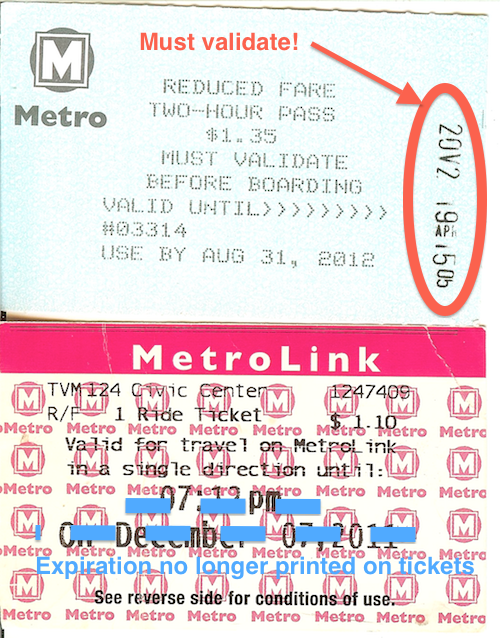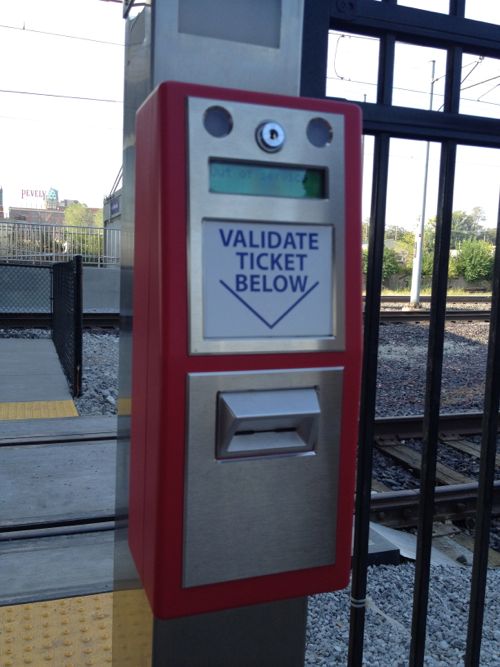Validate Your MetroLink Ticket
Metro has announced a change of policy regarding MetroLink ticket validation, effective today:
Starting Monday, January 7, 2013, all MetroLink tickets and 2-hour passes will need to be validated by customers prior to boarding the trains. The ticket vending machines will no longer automatically print the expiration time on these tickets or passes. This will allow customers the flexibility to purchase Metro tickets in advance of their trip, and then validate ticket when they are ready to use them. It also will eliminate confusion over whether or not tickets need to be validated. The following fares must be validated starting January 7.
- Ride Ticket
- Hour Pass
- Round-Trip Tickets (each ticket immediately prior to travel)
- Tickets from 10-Ride Ticket Booklets
I personally welcome this change, it allows buying a ticket before you need it.


The change is already in place.
— Steve Patterson
It’s kind of a lateral move, if you ask me.
The first, and most obvious question, is: why did we even have validation machines before if the time stamp was already printed on the ticket? It should have been one or the other because, as the press release says, there was always confusion about which was the proper protocol. And a lot of that confusion came from Metro operators/ticketers themselves.
Personally, I like the idea of removing the validation machines and going purely off the time stamps. It’s simple, it’s matter-of-fact, and it removes the “Oh, I didn’t know…” or “The machine was broken…” possibilities that some will inevitably use to try to con a free ride or two (or several).
I’m not convinced the “convenience” of pre-purchasing fares makes up for the headaches of enforcement and cheapskate work-arounds.
Because convenience makes transit more attractive. If I can buy two or four or ten tickets at one time, it saves me future time that would have to be spent at the TVM’s, it means that fewer people would have to wait to use the TVM’s (waiting for me each time) and it makes it a lot easier for me to make a tight connection when I’m “running late”. The only way to reduce the abuse you speak of is to go (back) to paying as you board, monitored by a human operator and/or to create a closed system on Metrolink, with fences, gates, turnstiles and additional staff. This all gets down to a basic cost versus benefit analysis – does Metro net more revenue with the present system (warts and all) or would they net more by hiring more staff, installing more barriers and cracking down on scofflaws more vigorously? It’s not much different than parking enforcement – doubling the number of officers on patrol will not double the amount of revenue generated – you’d be lucky to see a 50% increase. Ultimately, the real answer will be the move to “smart card” technology – it’s a lot harder to scam the system when it’s based on software and electrons than when it’s based on ink and paper . . . .
Conversely, I think multiple (and potentially duplicative) steps to board a train reduce convenience and, by virtue of that, attractiveness of the mode.
I understand that pre-buying allows you to skip the purchase lines you may encounter later (say, after a Cardinals game), but instead of 1000 people taking one step at 2-3 ticket vestibules, you now have 1000 people taking two steps at 2-3 ticket vestibules and 2-3 validation stations (stations that, across the board, seem to be out of service regularly/get gum stuck in the slot). And THEN there’s the added step of on-train ticket checks (which is necessary until a closed boarding system is implemented).
You know what convenience is? The monthly or weekly pass to bypass the lines and the crowds. It’s obviously most used by City residents, but that’s exactly the people to whom we need to provide that convenience — to encourage increased usage within the City which it serves. I don’t care if a visitor or once-a-month ‘burber has to spend a little more time on the platform because they have to buy their single one-way ticket.
You seem to be making conflicting points. Yes, a pass, of any type, is way easier to use than buying a ticket, then validating it. But passes only make sense, financially, if you’re a regular user. If you ride infrequently, as I do, buying a dozen individual ride tickets at one time (one somewhat-convoluted transaction), then validating each one once, one more time (12 very quick transactions) is way easier than repeating the somewhat-convoluted process of using the TVM each time. (And yes, the validators need to work better, since they’re a critical part of the current system.)
In reality, we already have a hybrid between an open and a closed system, with guards many times checking every passenger as they enter the platform area, especially at busier times and busier stations. And after big events (like Cardinal games), the guards validate tickets manually, so that’s never an issue. The big issue with big events is simply one of capacity, Metro can move only so many people with their current limit of two-car trains. Other properties, with bigger stations and longer platforms can run trains with 3, 4 or more cars (increasing the capacity of each train by 50% or 100% or more) and moving a LOT more people more quickly. If using Metrolink to get to and from Busch Stadium didn’t always involve a half-hour wait (or more) and packed cars after the game, that would be convenience and encourage more ridership!
There’s definitely a middle ground there.
Maybe maintain a single validator at each station used solely for future-use tickets (bought, in your example, by the dozen), and use the standard auto-validated immediate-use tickets for all others.
I know we both agree, though, that the best scenario is a closed, card-automated system. Users can opt to buy a 30-day/15-day/7-day/3-day pass (partner with Schnucks to provide points-of-sale) or choose to pay a dollar amount of their choosing into a reloadable pre-paid card purchasable at individual stations and visitor centers.
In this way, you remove most of the confusion/frustration about fare types.